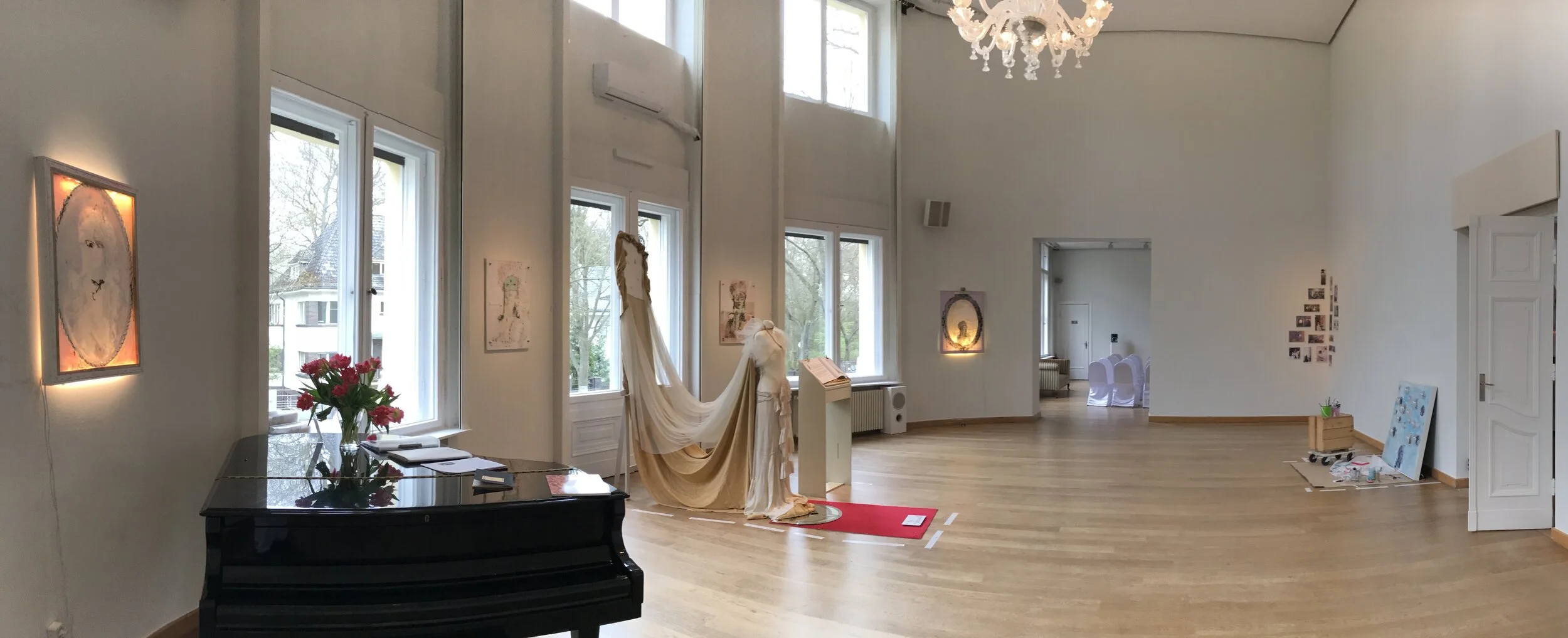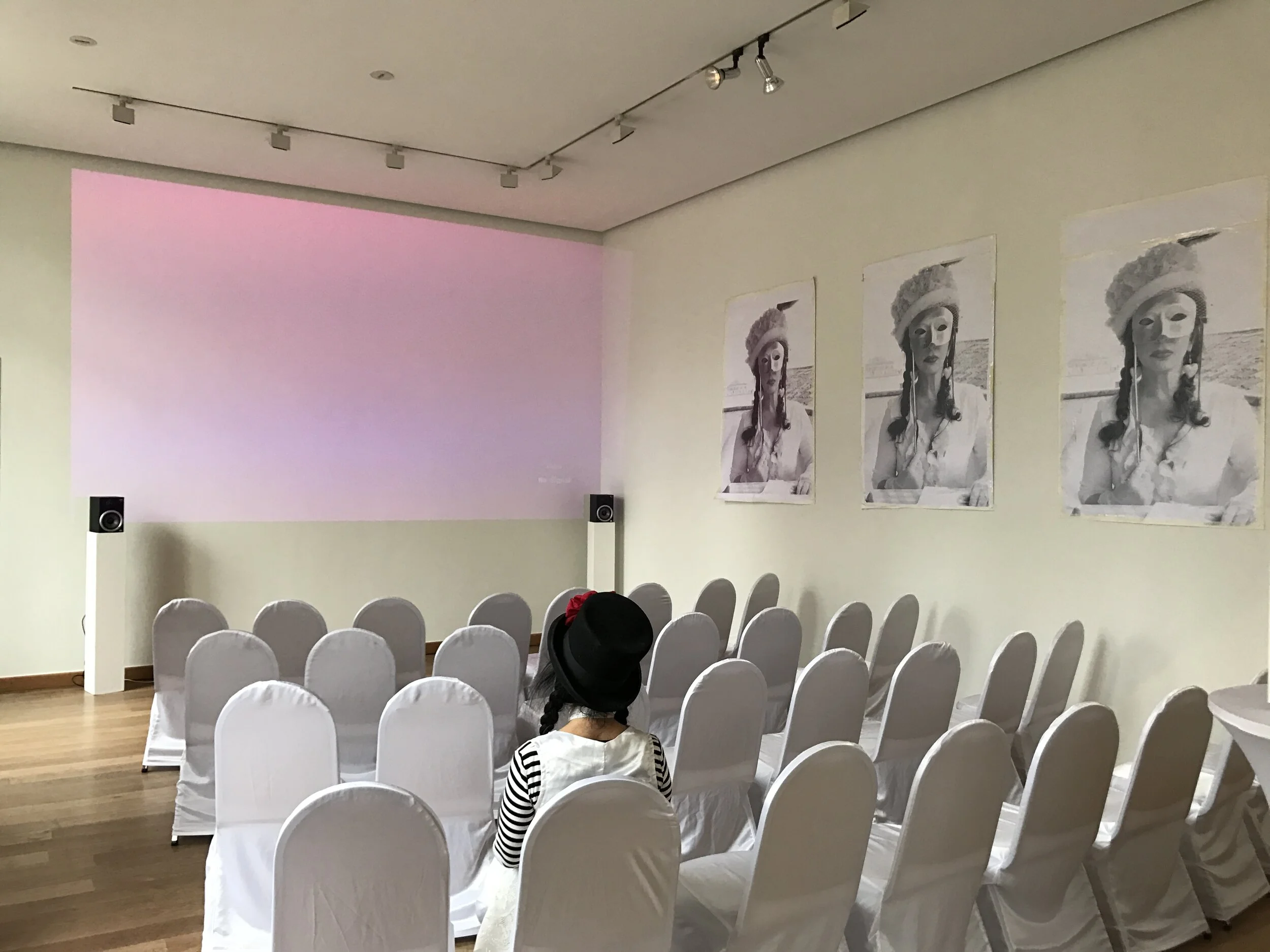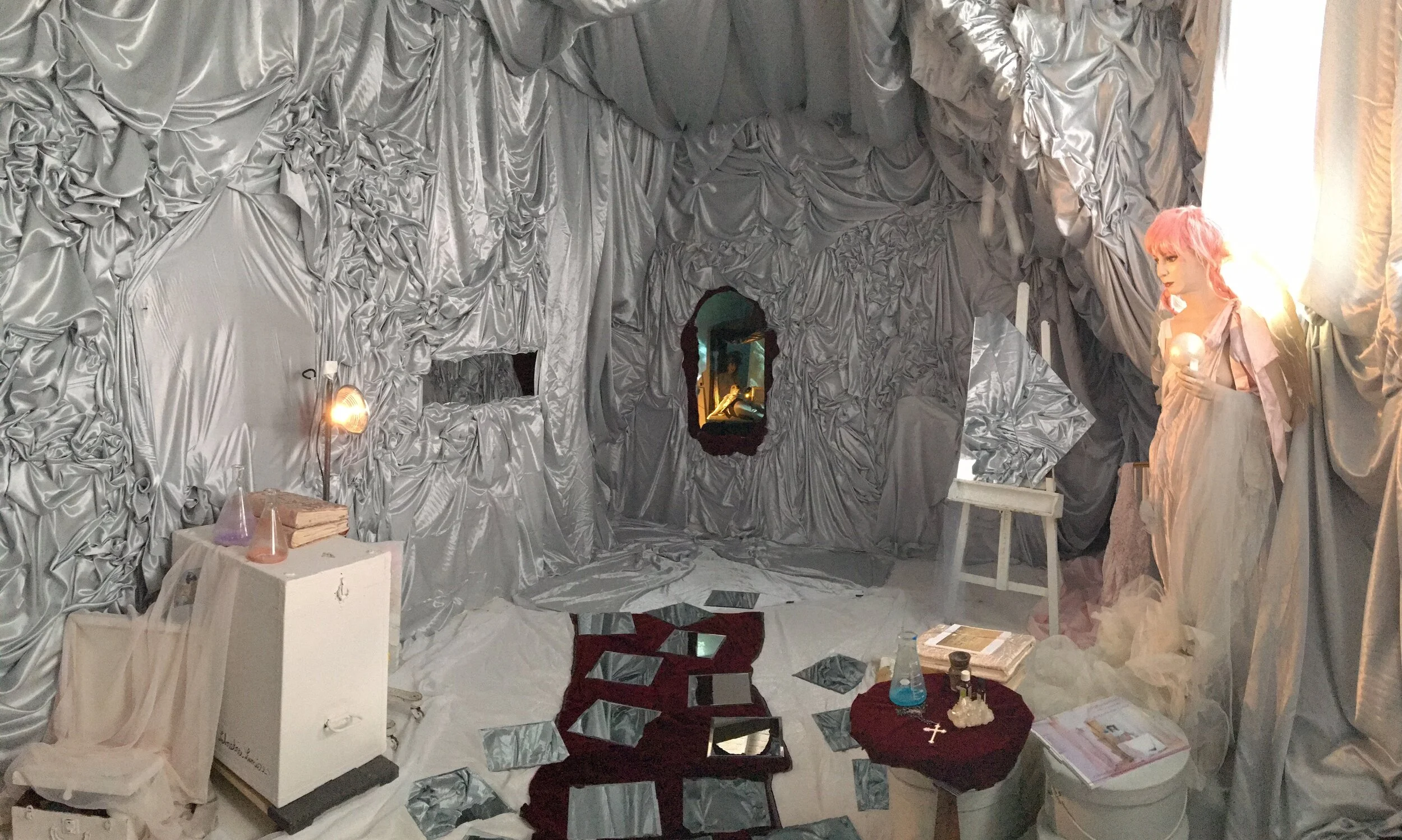Colette Lumiere, "The Woman With the Golden Mask" series. 2015-2017. Image by colette the artist. 2017.
Where are you based right now and what are you working on at the moment?
I have been spending most of my time in Berlin since 2015 on an extended residency at The Starke Art Foundation. I am not a stranger to this big city. In 1984, when the wall was still up and the city less populated, I was invited by the DAAD grant to live there, and remained through 1985.
The Löwenpalais, aka The Starke Art Foundation, is a beautiful, large old villa. I held a "Colette Salon" there in the nineties during my Reign as Olympia. Olympia was a persona that appropriated the art and spirit of the 18th century. In 2000 the building was renovated and the Salon was dismantled—but some of my artworks remain on the walls of the current Foyer. In 2001, I had a solo exhibition there in the luxurious rooms of the building's gallery space…Other artists who exhibited around that time were Yoko Ono, Sol Lewitt, Rebecca Horn, and Lawrence Weiner.
In 2015 I had another solo exhibition there titled: Lumiere Occupies the Löwenpalais. I literally invaded the building, using spaces that were not usually open to the public. I installed my office in the Central Room of the gallery space, and conducted my work there throughout the duration of the show. In another room in an upstairs apartment which was only opened partially, I appeared in a tableau creating portraits in "a reconstructed Art Laboratoire," oblivious to my audience. One of the abandoned rooms in the basement, which still remains, is dedicated to my Berlin persona of the 80’s—Mata Hari & the Stolen Potatoes (1984-85). In the Colette Foyer are presented works from the Dial C for Scandal Series: the Bavarian Adventure. The persona for that was Countess Reichenbach (1986-89).
Living in Berlin at the Löwenpalais has granted me the freedom to continue my experiments and obtain some distance from the New York Art Scene. I compare my presentations here as a “Rehearsal” (also the title of one of the current show’s installation). Here I have the opportunity to preview and review my new and old works—in a beautiful, non commercial venue—to a varied audience. Living here is not my final destination, but a transition. Bowie himself spent time in Berlin with a similar intent.
This March, the Starke Foundation presented" Lumiere Occupies the LöwenpalaisII." It is an installation in progress that featured some of my new works. In the central room of the Luxurious gallery space was an installation titled The Rehearsal.
"The Rehearsal" in the Central Room. From Lumiere Occupies the Löwenpalais. Foundation Starke. March 2017. copyright Colette the artist.
"A Pirate in Venice," a 35 minute film by Friederike Schaefer documenting my time in Venice during the 2011 Biennale, was presented for the first time in Berlin. Other video documentaries of my work by Al Hansen, Anton Perich, Charlie Ahearn, Michel Auder, Paul Tschinkell, Robert Polidori and Marc Miller, etc., were also projected on a large screen amongst my own videos in an installation as part of the exhibition titled: "The Screening Room."
The current exhibition also revolved around a central image of "The Woman With the Golden Mask," which initially appeared in post ups throughout the city when I first arrived in 2015, thus bringing it full circle. One collector called her "My Marilyn,” referring to Warhol's iconic image of Monroe. From 2015 until now, this image has been altered and recycled in many forms, from post ups to photo works, to individual mixed media art pieces. It is an emblem for "the Unknown Artist" of Berlin, a response to the city overpopulated by artists all aiming to gain notoriety. I continue to travel to and from NYC, and I plan to return there permanently when my mission is accomplished and my Berlin projects are completed.
"THE SCREENING ROOM." Installation View. Lumiere Occupies the Lowen Palais. March 2017. colette the artist.
What first inspired you to create environments, and what keeps you coming back to this medium?
I began my career as a painter. From the beginning, I felt an innate urge to become one with my environment and discovered a way to express it visually. I was also exploring space outside of the studio. In the early seventies I took to the streets and used them as my canvas. My street paintings were conducted as rituals. I dressed up for them and created them at very early hours of the day—a time when everything real seems to be unreal. Simultaneously, I began transforming my living space into a sculpture: draped its walls and furniture with soft white silk parachutes and created a dress code that was in visual harmony with it, thus creating myself into a sculpture within a sculpture.
The word got out, and I began exhibiting my artworks and environments in well known galleries and museums. I continued to present my work in less traditional venues in order to continue my dialogue with varied and diverse audiences. Department store windows and nightclubs were favorites, as they offered a great framework for commenting on the line between art and commerce. The persona Justine of the Colette is Dead Co. was disseminated in this way. Colette staged her death in a performance at the Whitney Museum in '78 and resurrected as Justine, a marketing genius who commercialized Colette's vision titled "Reverse Pop Series" (78-83). The series was "a parody, a solution to the dilemma of a young innovative artist, whose vision was wildly copied by the commercial world..."
The series prophesized the future disappearance of the Line between Art and Commerce we are now facing, and its consequences...
...Anyone that knows me or has worked with me will tell you that the incubation period has to be complete for the sharing to take place! And the private me only becomes public then.
In 1975, I described my activity in Lives, a catalogue curated by Jeffrey Deitch, as "creating a landscape and becoming part of it." That catalogue documented a show with Bueys, Warhol, and younger artists like myself who were using their actual life in their work.
Using soft, crinkled fabrics stapled onto wood, mirrors, and embedded lighting that sometimes incorporated audio, I would create environments that were inspired by mythology, e.g. Persephone; literature, e.g. Camille; art history, e.g. Madame Récamier. I often reclined with eyes closed on a divan or bed, and this was a central element. Like the ruins of sacred sites and ancient buildings, the remains of these installations—wall fragments, props, images, costumes—would be recycled into new art works.
I keep coming back to this medium of installations and performance because it became evident that it was the most powerful tool I had to explore as well as transmit the magic of Art and Life.
Guided by a new persona, my environments and my live tableaux have evolved since their beginnings. My street work has also evolved, as one can see in the 2012 documentary, A Pirate in Venice.
I still dream of a permanent installation in a public institution or museum. I would love the opportunity to Colettesize a meditative space, a bedroom in a private home, or a hotel lobby. I was commissioned to do an entire floor of an art/fashion building in Tokyo—the HPGRP building in Ginza. It was a gesamtkunstwerk and existed between 2003-2006, eventually being dismantled. I also created sets and costumes for the Berlin Opera in 1985. The sets and costumes are still preserved, but it is not accessible to the public. In 1983 the late Leo Castelli had almost succeeded in placing that living environment in a museum—but it now still remains in storage.
Can you explain why dreaming and the line between waking and the dream state informs your work? Is it your response to the human condition and what goes on in the world? Or is it a deep paradigm of your personality that teeters between the dream world and this one?
All of the above. There are many influences at play, all related to a deep wish to discover the nature of reality as well as the desire to achieve a state of inner balance, unity, and well being. I am always pleased to hear that my environments alter the state of the spectator to one of Inner Stillness.
Through the use of role playing and taking on various personas and guises, I created a series of photo works of myself in exaggerated female postures. The aim was to bring to question the origins of male and female genders.
The line between dreaming and waking was more directly addressed in the room installations where I laid still with eyes closed and in the light boxes that incorporated the images. I have always been interested in Metaphysics and Alchemy, the art of transformation, nature’s miracles, camouflage, mimicry, metamorphosis. I am extremely curious and fascinated by phenomena and the immaterial, the invisible, resurrection, shape shifting, higher dimensions, angels, aliens, galaxies, parallel universes, time traveling, timelessness...you name it!
Clearly the visual language—the language of symbols—held the key to a greater understanding of all these mysteries. It has always enabled me to access and transmit, like a medium, my visions, in the form of drawings, paintings, light boxes, objects, living tableaux…
One could say my life and art became an ongoing experiment, a metaphor, a work in progress. I created and lived in a dream world, and thus was creating my own visual reality.
In 1984, even The Inquirer magazine published an article about me, and its headline was: She Lives in a Nightmare, meaning "a dream." Ah…But they are known for distorting facts and winning readers through negative and weird headlines.
In your work you've often used soft lavenders, creams, and pinks. Where does the vision for this palette come from?
I am naturally drawn to soft, muted colors—more than basic pastels: colors found in dreams and visions.
"There is a Mermaid in the Attic" Installation View. #40 Exhibition PS1MOMA. June/Nov 2016. colette the artist.
When you first started creating environments, how did you acquire your fabric and materials? How has that process changed over the years?
I discovered silk parachute in the army and navy stores, and I began using them, as I already mentioned, to cover everything. I fell in love with the fold of the fabrics and began to invent ways of rushing and crinkling the materials, making them softer and lighter in texture and color. As time went on I experimented with other fabrics besides silks and found a way to treat satin, to get rid of its shine and stiffness. To achieve a more futuristic space age look I even experimented with metallic fabrics in silver, gold, and copper.
Witnessing the dismantling of these works—entire rooms—is always traumatic, although their impermanence is part of the poetry and message.
What projects will you be creating in this new year?
My number one desire and goal now is to complete works in progress: Berlin Diaries and more ephemeral projects—for instance, the ongoing investigation and deciphering of a discovered 1975 cassette interview of myself and Warhol. This will be presented in a film at a Paris gallery in collaboration with others (more to be announced soon).
I look forward to being able to shut off all the noise from the world and travel again in my own universe: my laboratoireLumiere.
And I will continue to conduct my art experiments. Perhaps I am ready to create a new Persona?
It has been an eventful year. I am proud to say I am a Guggenheim recipient. I have also been greatly inspired from my recent adventures and experiences. I feel I am in the middle of an important transition and have much material to work with.
This last June, I presented The Mermaid in the Attic for PS1 MOMA’s FORTY exhibition. The environment was set in the exact same space where I posed as Marat with eyes closed in an installation titled David’s Wrath in 1976. That was for the opening exhibition of Rooms, curated by its founder Alanna Heiss. A special thank you must be given to MOMA’s current director, Klaus Biesenbach, who encouraged me to create an installation, as well as to Oliver Schulz, who assisted me.
In the recent work, I posed in a small room within the main installation. The reflection of my body nude to the waist could be seen in the reflection of a large mirror. The performance was a tribute to Marcel Duchamp’s enigmatic last work, Étant Donnés. It was a complex installation, a work in progress. The main space recalled the unique sensation one has when entering an old attic: art works, props, books, ephemera, archival material. White trunks were spread around the attic space and its main fabric installation.
The complex and large installation has recently beendismantled, due to reconstruction of the roof. It is always a sad and poignant moment for me when that happens...like a death. I had hoped it would remain a permanent work like the Turrell Room. I have always dreamt of a permanent installation in a public space. This news also reminds me of the importance of finding the right institution to save my archive. So many important facts and information in the recording of "Art History" and the scene of the 70's and 80's are being edited, deleted, manipulated, and altered.
The art of being able to turn limitations into inspiration is a great gift, one I feel very fortunate to have. However, it does not eliminate my ability to create in more luxurious circumstances and allow other kinds of experimentation, such as the use of new materials and technology.
Last November, I had a very intense period in Zulu Land, South Africa: I was invited to live among the lions. There I participated in the Art Project Thanda’s Star for Life Foundation, organized and curated by Johan Falkman. It was an extremely intensive experience shared with other wonderful artists, a couple of art writers and curators, etc. We were provided with a huge, beautiful studio space with limitless art supplies and all demands met. I chose to create my art in nature, and mostly in my private quarters: my hut. There, I would display my personal belongings, drawings, and new items I bought in the market place, which I incorporated in a new installation: Les Tresors de Zulu Land. I am thrilled that my room installation remains as I left it—open to the public.
Most of us had never been immersed in nature in such a way, among wild animals: lions, giraffes, hippopotamus, buffalos, etc. We also visited the schools and the children. It was indescribably moving, so inspiring and new! When we arrived, many of us did not know each other, yet this experience bonded us. We left deeply moved, knowing our time there will forever stay with us.
Our last evening, after dinner, I invited all to my hut. To everyone's surprise, a local guard in traditional costume was guarding it. One could see my installation through the large glass doors; it looked like a large light box in the night. Later this year, we will all reunite. Our art will be part of a benefit auction that will take place at Stockholm's Auction House.
"Lumiere's hut.' An installation in Zulu Land, Africa. Nov. 2016. copyright colette the artist.
What is the best part of being an artist?
The best part of being an artist is to continue to grow and evolve, not only in our skill, but interiorly.
I have learned over the years that success and recognition are sweet but not something an artist can count on to measure her worth by. My strength is to continue to believe in my own power as an artist, no matter what happens externally. One can not rely on external conditions: people’s whims, opinions, trends, politics, and other madness, to continue to feel inspired. It has to come from within us.
The act of creation is a great blessing, and so is the process of discovery. Anyway, it takes time for others to catch up with the artist. "Catch her if U can" was the title of a performance I did for a SoHo Walk show organized by Marc Pottier in 1994.
To help me through the creative process of more problematic pieces I turn to a less demanding medium…drawing. I draw and paint faces in my unique style of friends and imaginary people. Some are portrait commissions, which I name “Metaphysical Portraits.” They have been described as resembling “navigational maps.” Over the last years I have done exhibitions where the new portraits were incorporated as part of an installation. It is very clear, when you look at the portraits hanging near each other, that even though each entity is separate and unique, there are threads connecting them...and they seem to reinforce visually the thought that we are all connected.




